Simulation Study of Ultrasonic Elliptical Vibration Cutting of TiC Particle-Reinforced Titanium Matrix Composites
Abstract
1. Introduction
2. Ultrasonic Elliptical Vibration Kinematic Model
3. Finite Element Simulation Modeling
4. Simulation Results and Analysis
4.1. Comparison of Surface Morphology
4.2. Comparison of Cutting Forces
4.3. Comparison of Cutting Temperature
4.4. Comparison of Particle Crushing to Remove Processing Defects
4.5. Comparison of Cutting Temperature
5. Conclusions
- Ultrasonic elliptical vibration cutting has a significant reduction in average cutting forces due to the periodic nature of the cutting. This is a result of the variable speed cutting action, with a 60% reduction in average cutting forces compared to conventional cutting;
- Ultrasonic elliptical vibration cutting briefly separates the tool from the chip during the rewind phase of each cutting period, during which the tool is cooled, resulting in a periodic wave-like rise in the temperature profile and a 17.6% reduction in the average cutting temperature compared to conventional cutting methods;
- By analyzing the stresses between the tool and the particles during co-located particle cutting, ultrasonic elliptical vibration cutting tends to have a horizontal direction of particle fragmentation and cracking, where the TiC particles are mainly removed by cutting off.
Author Contributions
Funding
Data Availability Statement
Conflicts of Interest
References
- Maciej, M. Titanium Alloys and Titanium-Based Matrix Composites. Metals 2021, 11, 1463. [Google Scholar]
- Jung, H.-D. Titanium and Its Alloys for Biomedical Applications. Metals 2021, 11, 1945. [Google Scholar] [CrossRef]
- Tan, R.; Zhao, X.; Sun, T.; Zou, X.; Hu, Z. Experimental Investigation on Micro-Groove Manufacturing of Ti-6Al-4V Alloy by Using Ultrasonic Elliptical Vibration Assisted Cutting. Materials 2019, 12, 3086. [Google Scholar] [CrossRef]
- Han, Y.; Sun, X.; Qiu, P.; Mao, J.; Zhang, D. Research and progress of advanced processing technology for particle reinforced titanium matrix composites. J. Compos. Mater. 2017, 34, 1625–1635. [Google Scholar] [CrossRef]
- Wang, M.; Li, S.; Zheng, Y.; Li, X. Effect of ultrasonic vibration milling parameters on cutting forces. China Mech. Eng. 2014, 25, 2024–2029. [Google Scholar]
- Ji, Y.; Li, X.; Zhang, D.Y. Ultrasonic elliptical vibration precision cutting. Aviat. Manuf. Technol. 2005, 4, 92–95. [Google Scholar]
- Tan, R. Fundamental Research on Ultrasonic Elliptical Vibration Assisted Ultra-Precision Cutting of Titanium Alloy. Ph.D. Thesis, Harbin Institute of Technology, Harbin, China, 2020. [Google Scholar]
- Muhammad, R.; Ahmed, N.; Demiral, M.; Roy, A.; Silberschmidt, V.V. Computational Study of Ultrasonically-Assisted Turning of Ti Alloys. Adv. Mater. Res. 2011, 223, 30–36. [Google Scholar] [CrossRef]
- Dong, T.; Zhang, M.; Li, Y.; Chen, J.; Liu, X. Numerical study on ultrasonic elliptical vibration cutting of aviation aluminum alloy. Light Ind. Mach. 2021, 39, 48–55. [Google Scholar]
- Tan, R.; Zhao, X.; Guo, S.; Zou, X.; He, Y.; Geng, Y.; Hu, Z.; Sun, T. Sustainable production of dry-ultra-precision machining of Ti–6Al–4V alloy using PCD tool under ultrasonic elliptical vibration-assisted cutting. J. Clean. Prod. 2020, 248, 119254. [Google Scholar] [CrossRef]
- Teng, J.; Feng, Z.; Jiao, F.; Zhao, B. Tool Wear in Longitudinal-Torsional Ultrasonic Vibration Milling of Titanium Alloys. Surf. Technol. 2019, 48, 297–303. [Google Scholar]
- Zhang, P.; Zhang, X.; Cao, X.; Yu, X.; Wang, Y. Analysis on the tool wear behavior of 7050-T7451 aluminum alloy under ultrasonic elliptical vibration cutting. Wear 2021, 466–467, 203538. [Google Scholar] [CrossRef]
- Usman, M.M.; Zou, P.; Ji, B.; Lin, T. Development of empirical models for the prediction of surface functional parameters in ultrasonic elliptical vibration cutting. Int. J. Adv. Manuf. Technol. 2021, 113, 2575–2594. [Google Scholar] [CrossRef]
- Teng, L.; Xiang, J.; Tao, W.; Wang, B.; Xie, L. Review upon Simulation of Cutting Process of Particulate Reinforced Metal Matrix Composites. Technology 2019, 53, 3–9. [Google Scholar]
- Jiang, Y.; Pi, J.; Yang, G.; Jiang, T.; Shen, Z. Effect of ultrasonic elliptical vibration cutting trajectory on surface morphology. J. Ordnance Eng. 2019, 40, 2170–2176. [Google Scholar]
- Chen, W.; Zhang, X. Investigation on the cutting mechanism of SiCp/Al composites in ultrasonic elliptical vibration machining. Int. J. Adv. Manuf. Technol. 2022, 120, 4707–4722. [Google Scholar] [CrossRef]
- Dai, C.; Yin, Z.; Zhao, M.; Cao, Z.; Li, H. Effect of Tilt Angle and Speed Ratio on Workpiece Micro Morphology in Ultrasonic Elliptical Vibration Cutting. Tool Technol. 2021, 55, 34–38. [Google Scholar]
- Tong, J.; Wei, G. Characterization of cutting forces in ultrasonic elliptical vibration cutting of titanium alloy. Vib. Impact 2019, 38, 208–215. [Google Scholar]
- Huan, H.; Xu, J.; Su, H.; Huo, F. Study on tool wear of PCD tool in turning titanium matrix composites. China Mech. Eng. 2016, 27, 1877–1883. [Google Scholar]
- Fathipour, M.; Hamedi, M.; Yousefi, R. Numerical and experimental analysis of machining of Al (20 vol% SiC) composite by the use of ABAQUS software. Mater. Werkst. 2013, 44, 14–20. [Google Scholar] [CrossRef]
- Li, S.; Han, J.; Yu, H.; Wang, J.; Lu, M.; Tian, Z.; Lin, J. Finite Element Investigation on Cutting Force and Residual Stress in 3D Elliptical Vibration Cutting Ti6Al4V. Micromachines 2022, 13, 1278. [Google Scholar] [CrossRef]
- Pantalé, O.; Bacaria, J.L.; Dalverny, O.; Rakotomalala, R.; Caperaa, S. 2D and 3D numerical models of metal cutting with damage effects. Comput. Methods Appl. Mech. Eng. 2004, 193, 4383–4399. [Google Scholar] [CrossRef]
- Mebrahitom, A.; Choon, W.; Azhari, A. Side Milling Machining Simulation Using Finite Element Analysis: Prediction of Cutting Forces. Mater. Today Proc. 2017, 4 Pt D, 5215–5221. [Google Scholar] [CrossRef]
- Xiang, D.; Shi, Z.; Feng, H.; Wu, B.; Zhang, Z.; Chen, Y.; Niu, X.; Zhao, B. Finite element analysis of ultrasonic assisted milling of SiCp/Al composites. Int. J. Adv. Manuf. Technol. 2019, 105, 3477–3488. [Google Scholar] [CrossRef]
- Ghandehariun, A.; Nazzal, M.; Kishawy, H.A.; Umer, U. On modeling the deformations and tool-workpiece interactions during machining metal matrix composites. Int. J. Adv. Manuf. Technol. 2017, 91, 1507–1516. [Google Scholar] [CrossRef]
- Chen, G.; Ren, C.; Zhang, P.; Cui, K.; Li, Y. Measurement and finite element simulation of micro-cutting temperatures of tool tip and workpiece. Int. J. Mach. Tools Manuf. 2013, 75, 16–26. [Google Scholar] [CrossRef]
- Han, X.; Zhang, D. Effects of separating characteristics in ultrasonic elliptical vibration-assisted milling on cutting force, chip, and surface morphologies. Int. J. Adv. Manuf. Technol. 2020, 108, 3075–3084. [Google Scholar] [CrossRef]
- Zheng, W.; Qu, D.; Qiao, G. Multi-phase modeling of SiC particle removal mechanism in ultrasonic vibration–assisted scratching of SiCp/Al composites. Int. J. Adv. Manuf. Technol. 2021, 113, 535–551. [Google Scholar] [CrossRef]
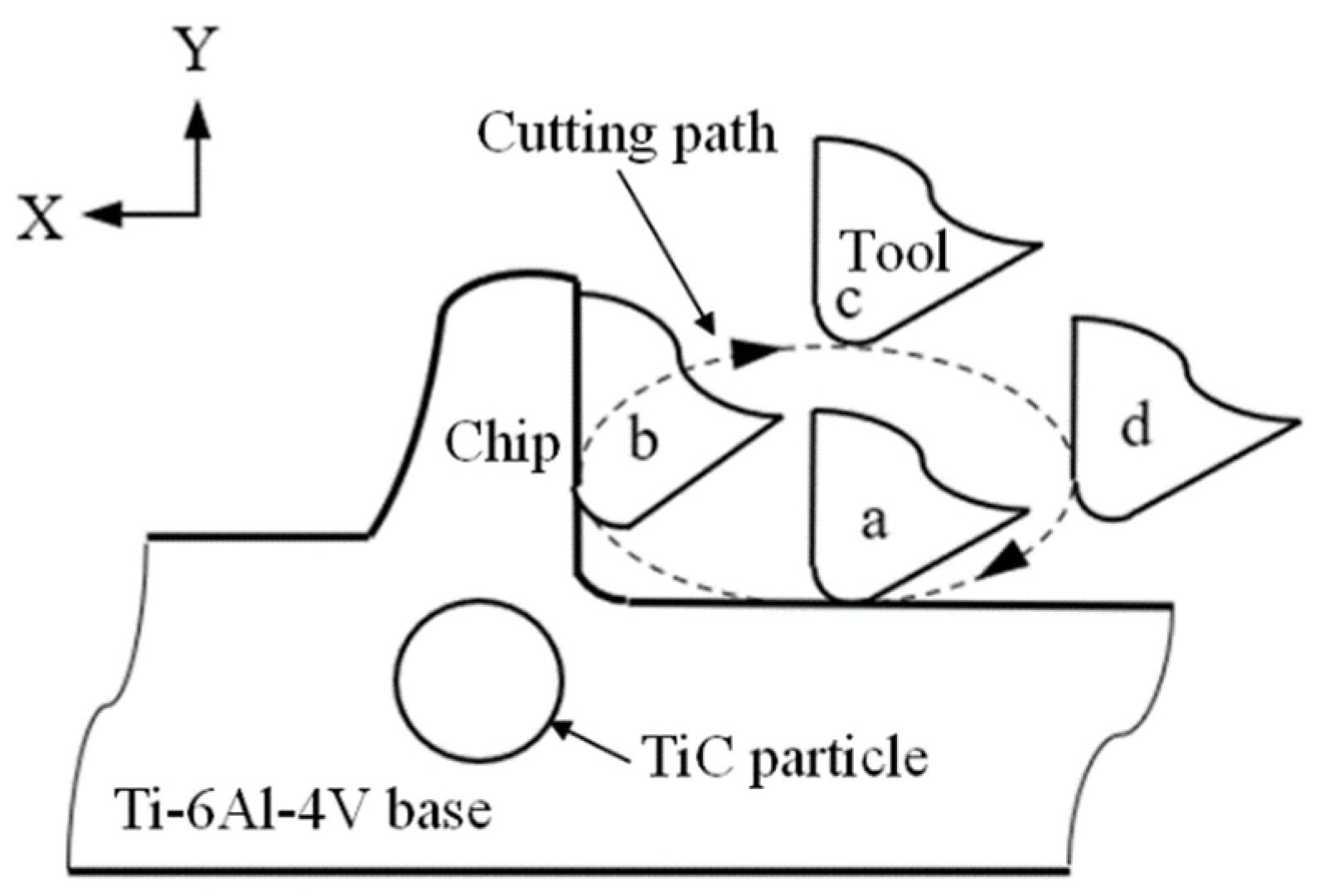

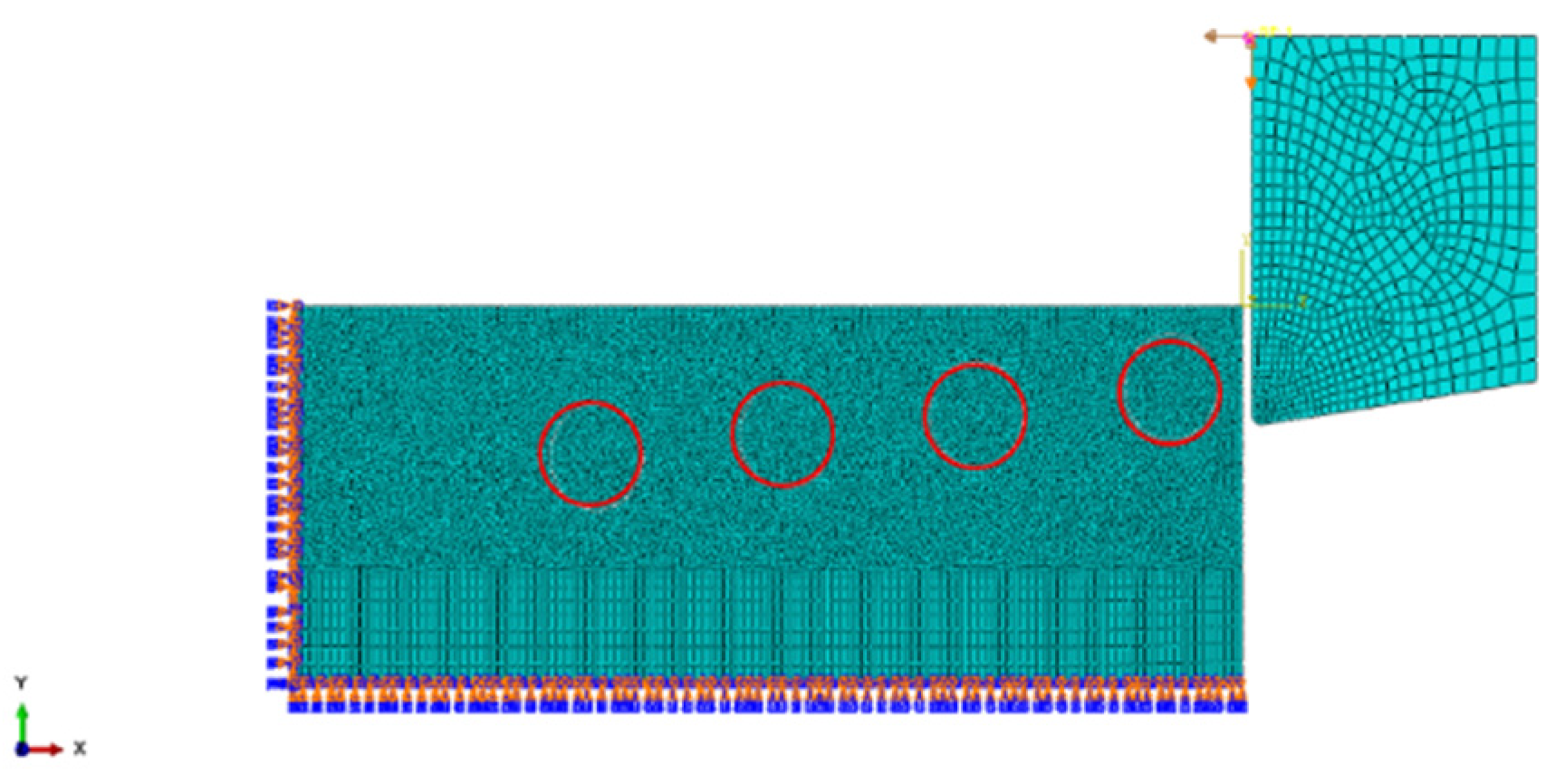
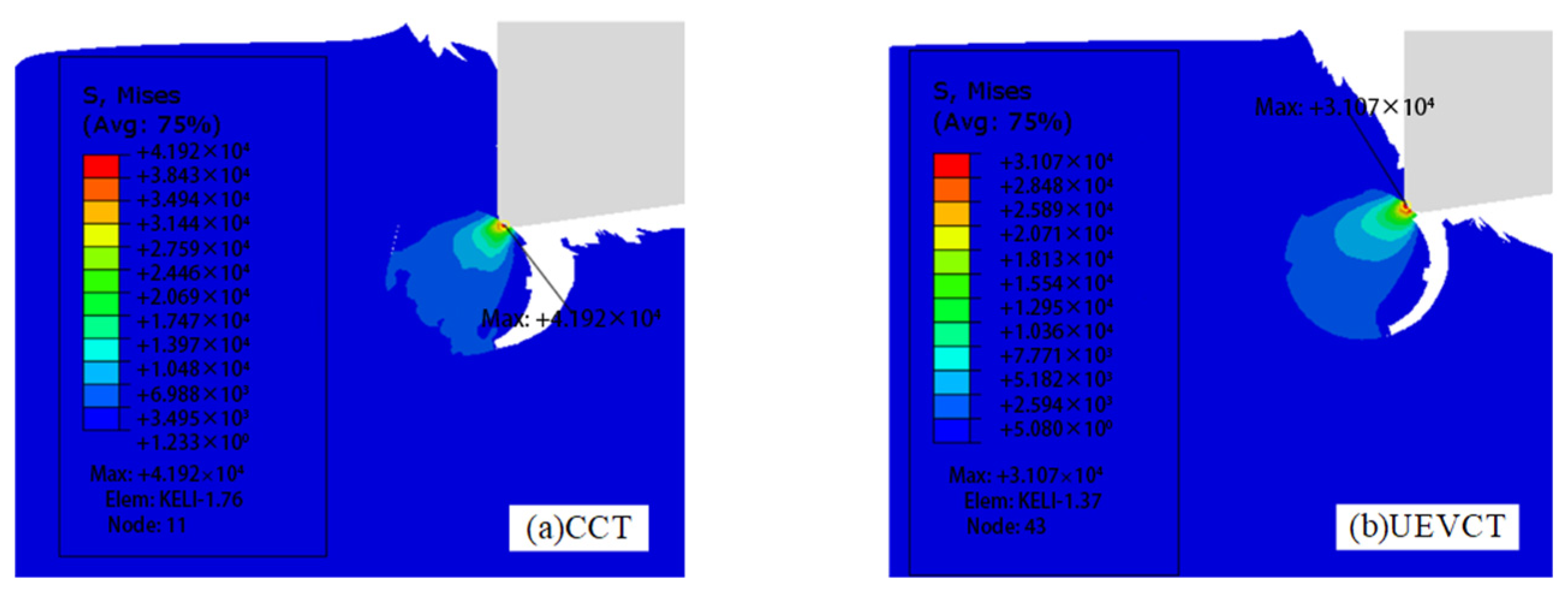
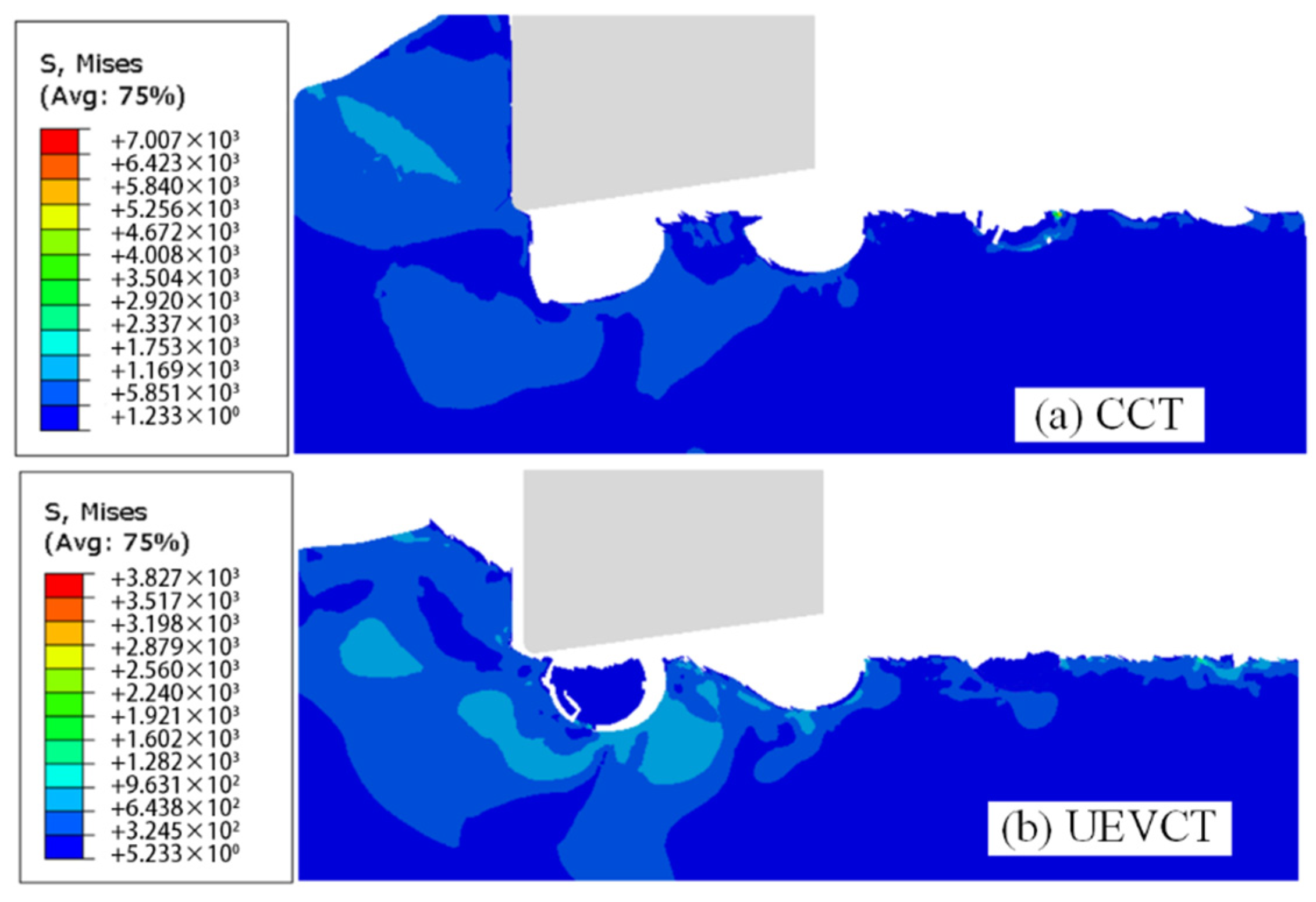
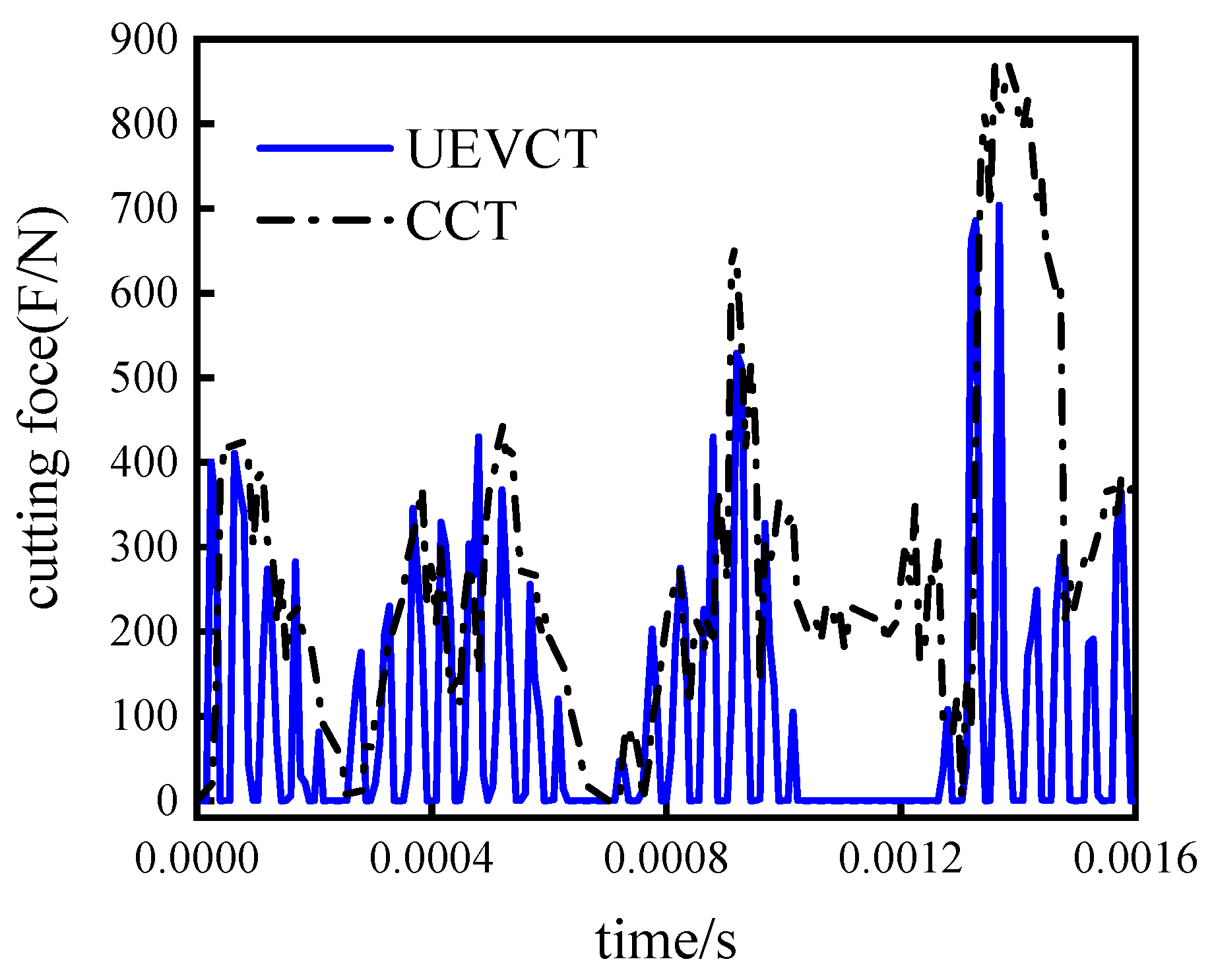


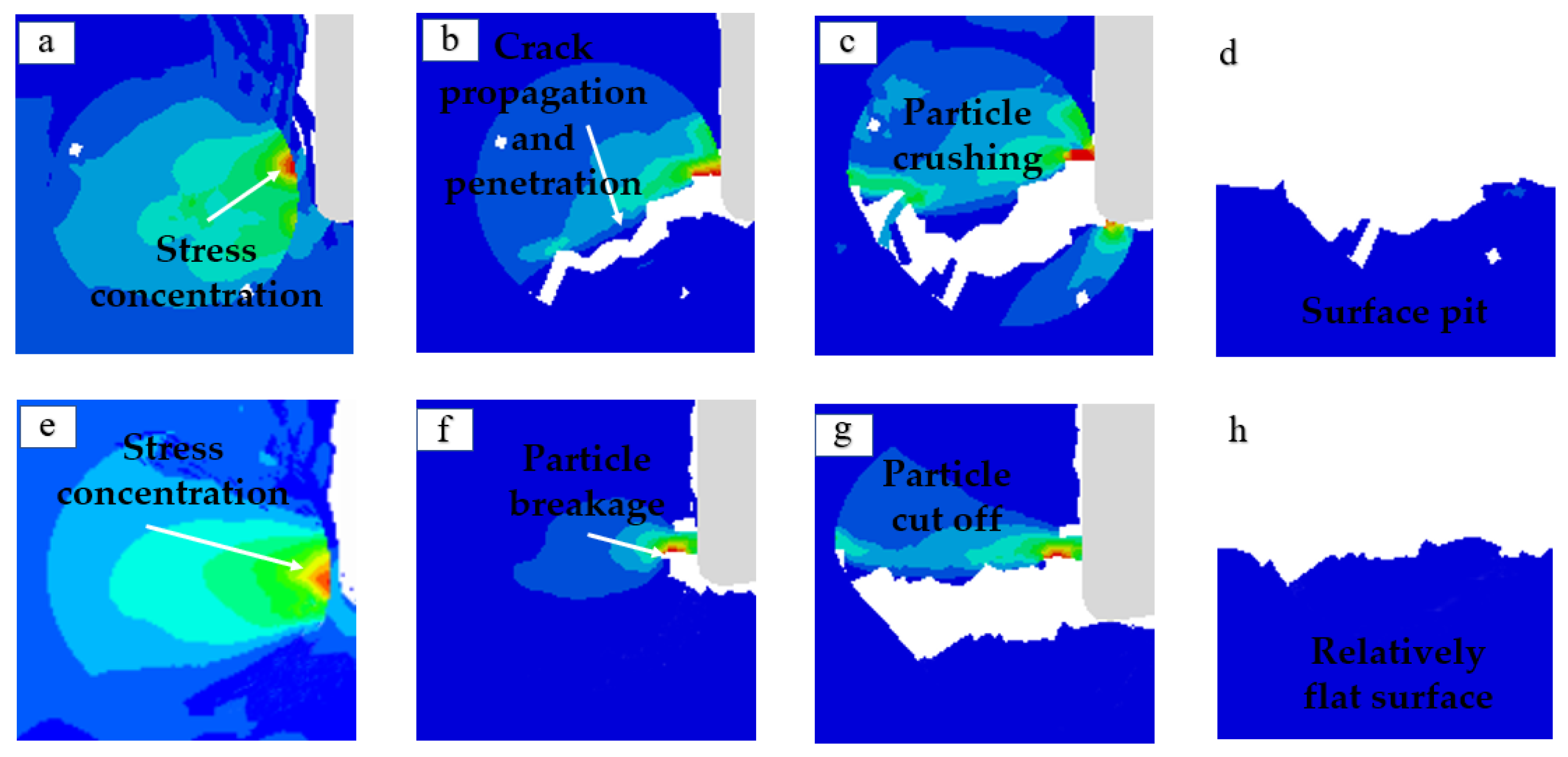

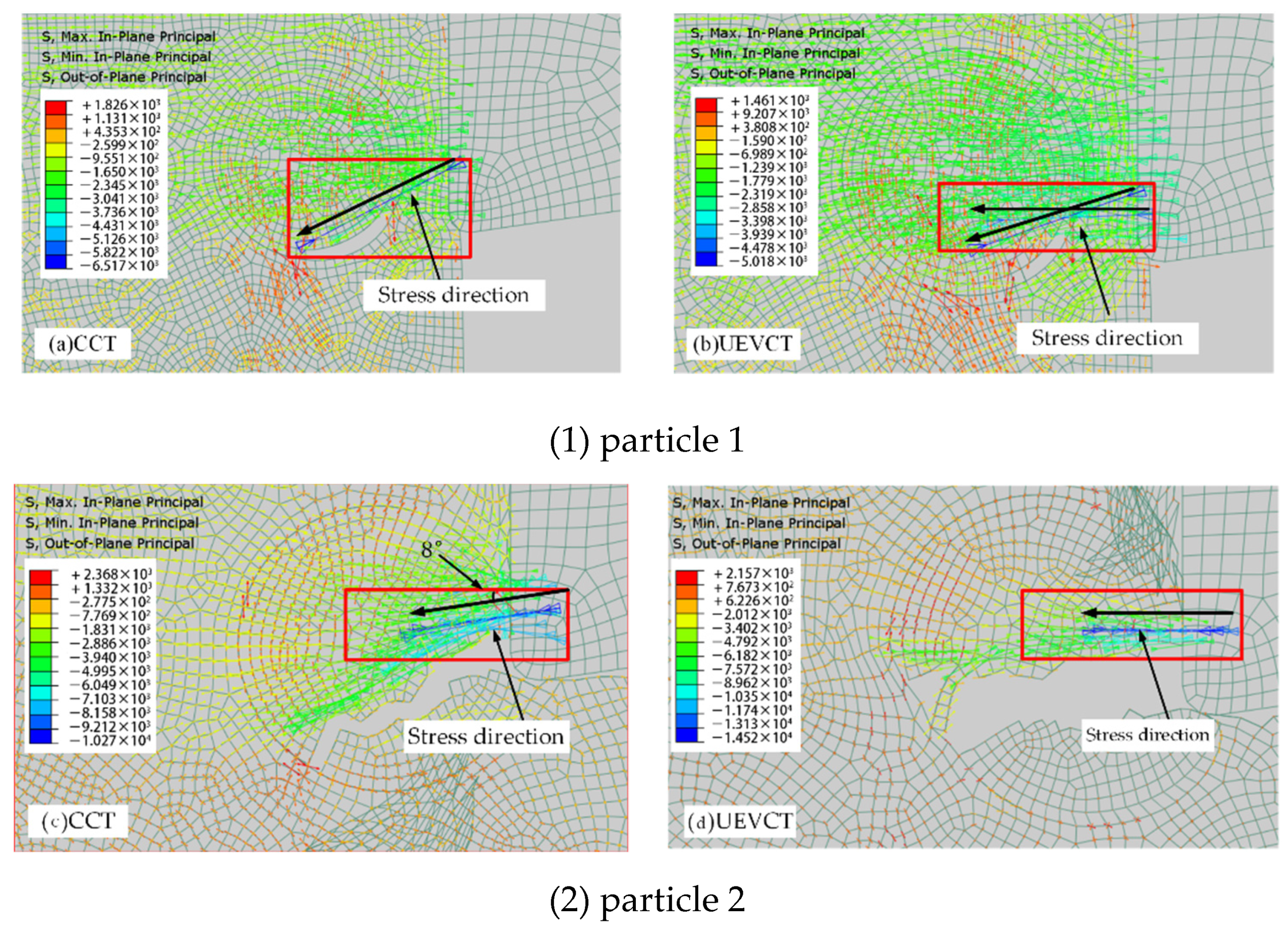
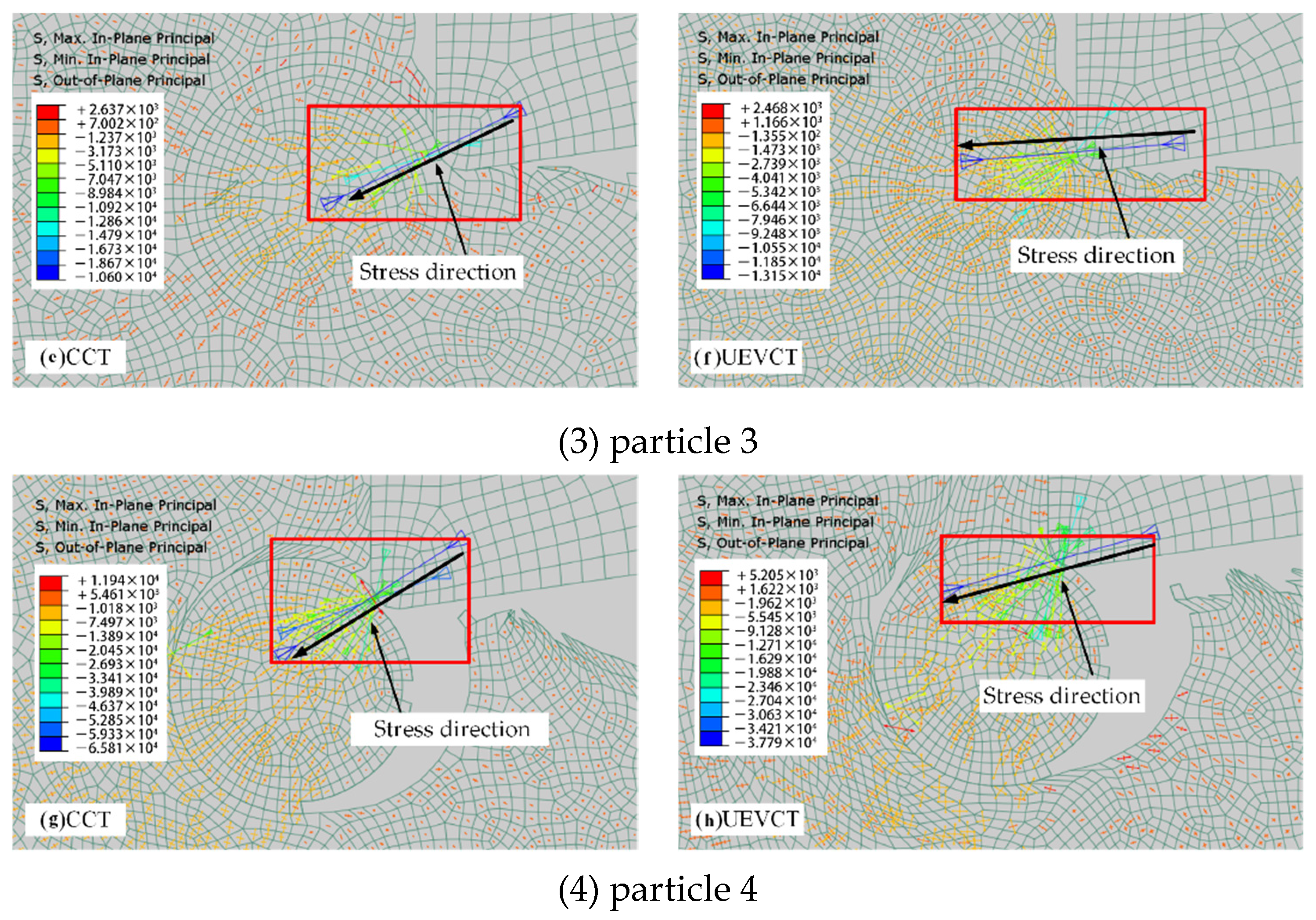


| A/MPa | B/MPa | C | n | m | /°C | /°C |
|---|---|---|---|---|---|---|
| 875 | 793 | 0.01 | 0.386 | 0.71 | 1560 | 20 |
| Category | Value |
|---|---|
| Density ρ (kg/m3) | 4930 |
| Poisson’s ratio | 0.2 |
| E (G Pa) | 500 |
| Hardness (G Pa) | 31.4 |
| Hard fracture toughness (MPa·m1/2) | 3.8 |
| D1 | D2 | D3 | D4 | D5 |
|---|---|---|---|---|
| −0.09 | 0.27 | −0.48 | 0.014 | 3.87 |
Publisher’s Note: MDPI stays neutral with regard to jurisdictional claims in published maps and institutional affiliations. |
© 2022 by the authors. Licensee MDPI, Basel, Switzerland. This article is an open access article distributed under the terms and conditions of the Creative Commons Attribution (CC BY) license (https://creativecommons.org/licenses/by/4.0/).
Share and Cite
Huan, H.; Xu, W.; Zhao, B.; Zhang, K.; Pu, J.; Zhu, C. Simulation Study of Ultrasonic Elliptical Vibration Cutting of TiC Particle-Reinforced Titanium Matrix Composites. Metals 2022, 12, 1769. https://doi.org/10.3390/met12101769
Huan H, Xu W, Zhao B, Zhang K, Pu J, Zhu C. Simulation Study of Ultrasonic Elliptical Vibration Cutting of TiC Particle-Reinforced Titanium Matrix Composites. Metals. 2022; 12(10):1769. https://doi.org/10.3390/met12101769
Chicago/Turabian StyleHuan, Haixiang, Wenqiang Xu, Biao Zhao, Ke Zhang, Jianfei Pu, and Chilei Zhu. 2022. "Simulation Study of Ultrasonic Elliptical Vibration Cutting of TiC Particle-Reinforced Titanium Matrix Composites" Metals 12, no. 10: 1769. https://doi.org/10.3390/met12101769
APA StyleHuan, H., Xu, W., Zhao, B., Zhang, K., Pu, J., & Zhu, C. (2022). Simulation Study of Ultrasonic Elliptical Vibration Cutting of TiC Particle-Reinforced Titanium Matrix Composites. Metals, 12(10), 1769. https://doi.org/10.3390/met12101769







